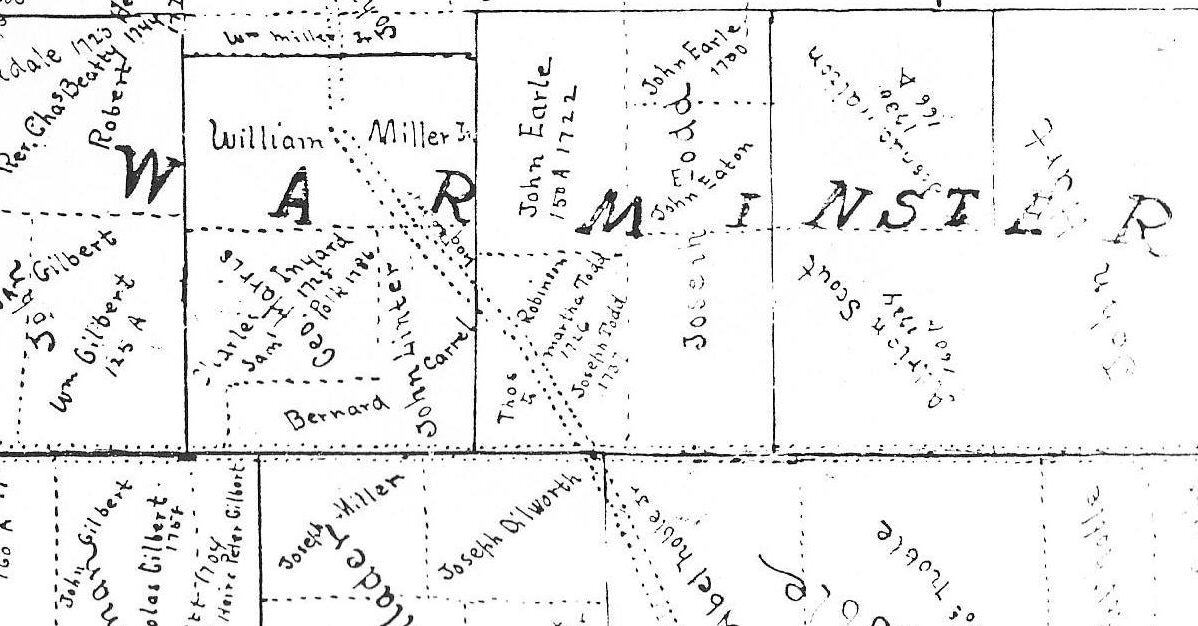Below is our latest journal which focuses on the earliest history of William Tennent’s 100-acre plantation in Warminster, and the real possibility that the house was used to operate a business for a brief period of time before Tennent owned it. We also explore the potential entanglement of the Tennent property’s ownership history with that of the tavern now known as Mike’s York Street . Read how a 1730 petition for a license “to keep a house of entertainment for man and horse” may not have been intended for the tavern at York and Street Roads, but rather what would become Tennent’s house.
The public sale notice shown below from the February 11, 1734/5 Pennsylvania Gazette describes the Tennent “Hundred Acres” as “having a large commodious House, fit for either a Store or Tavern”.
The William Tennent House stands prominently alongside a former roadbed of a portion of Old York Road, which was once the primary 18th century travel route between New York and Philadelphia. This part of the original route was closed once the new York Road was constructed a little further east, in the late 1960s. Although the house has been altered and changed through time, its close proximity to the road is undeniably much the same as other area 18th century businesses were along the same route.
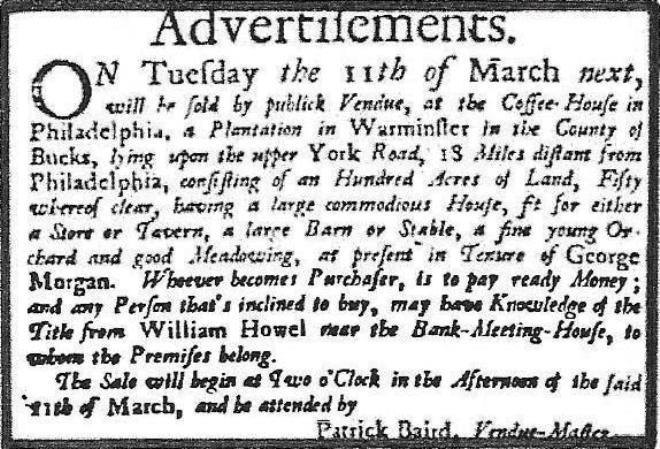
The Store
What we know of the earliest history of Tennent’s plantation was that on March 24, 1724, the Trustees of the Free Society of Traders in Pennsylvania gave James Steel of Philadelphia (Receiver General for the Penn family at that time) a warrant for 1,000 acres. The next day, a warrant for the survey of 100 acres was made out and laid off for Steel. James Steel sold the 100 acres on September 13, 1728 to John Linter of Warminster for 60 pounds (pounds being a term of the British monetary system used in the American colonies at the time).
John Linter then mortgaged the property to John Roberts, a Philadelphia shopkeeper, on May 29, 1730. A messuage (dwelling house) is mentioned in this mortgage, and we speculate it was possible the house was built by either James Steel or John Linter, between 1724 (when the 100 acres came in to being) and 1730, for the purpose of being used as a store, tavern or public business.
John Roberts passed away between January 2 and May 4 of 1731. In the Philadelphia will abstracts, Roberts is listed as a Philadelphia merchant, and his wife, Jane Roberts, along with John White and John Cadwalader are listed in the will as executors of John Roberts’ estate. White and Cadwalader are also listed as friends, and will become men of interest as you continue to read.
On June 30, 1732, John Linter, who was listed as late of Warminster but now of New York, yeoman, through Thomas Davids of Northampton Township, to whom he had given power of attorney on May 2, 1732, sold the 100-acre property to Joseph Howell, another Philadelphia shopkeeper, and Jane, his wife (who just happened to be the same Jane who was the widow of John Roberts), for 260 pounds.
Unfortunately, Joseph Howell died between December 14, 1732 and January 4, 1733. Joseph’s brother, William Howell, and his wife, Martha, were executors of Joseph’s estate. Joseph’s wife, Jane, was not listed in any capacity in the abstract of Joseph’s will, and there is no indication in the Philadelphia will abstracts that she had died yet at this point in time.
Joseph Howell, at the time of his death, owed John White and Abraham Taylor, two Philadelphia merchants, just over 71 pounds. Joseph’s “Goods and Chattels” in possession of William and Martha Howell were valued at 30 pounds, leaving an outstanding balance of 41 pounds. In the preceding public sale notice on page 1, you can see there was an attempt by William Howell to sell the property on March 11, 1734/5. Because the remaining balance could not be paid within a reasonable period of time, Timothy Smith, Sheriff of Bucks County, seized the 100-acre plantation by order of the Philadelphia courts and eventually sold it at public sale to the highest bidder, merchant John White, for 121 pounds on August 30, 1735.
If you know anything about colonial merchants, then you’ll know they were the kings of the 18th century business world, and shopkeepers and other retailers usually secured their goods to be sold on credit from those merchants, which was normal practice at that time. It is most likely this was the case between Joseph Howell and merchants Taylor and White. We also believe there may have been this type of business relationship between John Roberts and John White, and a personal connection as well with White being listed as one of Roberts’ executors and friends in his will.
We dug into the backgrounds of our two merchants the Howells were indebted to and found that Abraham Taylor had entered “into partnership in 1724 with John White as “Merchant-Adventurer” in the North Atlantic trade. The business was very profitable but in 1741, White, wishing to return to England sold his interest to Taylor for £7000 [pounds] sterling. After John White had returned to England and established himself first at Bristol and afterwards, when he retired, at Croydon, Surrey, Abram maintained communications with his erstwhile partner and friend.”
All of our evidence up to this point seemed to indicate John Linter had intended the house Tennent would eventually own to be used as a public business from the start and that at least for a brief period of time between 1730 and 1733, a Store may have been open for business mainly due to the driving force of Jane Howell, who when lost one shopkeeper husband, remarried another shopkeeper, only for it all to finally end with the loss of Joseph in such a short period of time. We do wonder what became of Jane…Roberts…Howell, and will continue to search for any clues.
John White did not have any interest in holding the property for very long and was able to make a small profit by selling it to the Reverend William Tennent on September 11, 1735 for 140 pounds.
There is no documentation to indicate Tennent ever used or intended to use the house as a business. There is only evidence he did not alter or change the house to a point where he couldn’t advertise the house himself as also…you guessed it…”suitable for keeping Store or Tavern”. Following are two ads, dated 1742 and 1744 respectively, where William Tennent was looking to sell “the plantation that he now lives upon”.
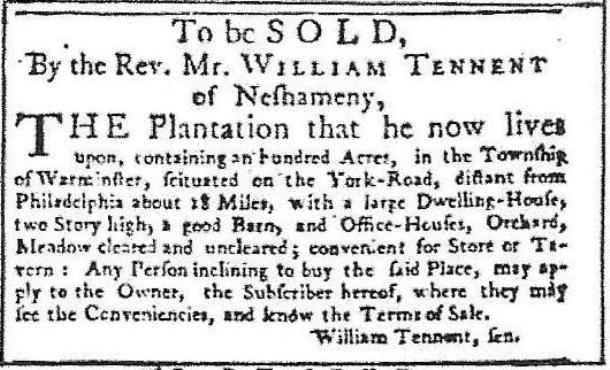
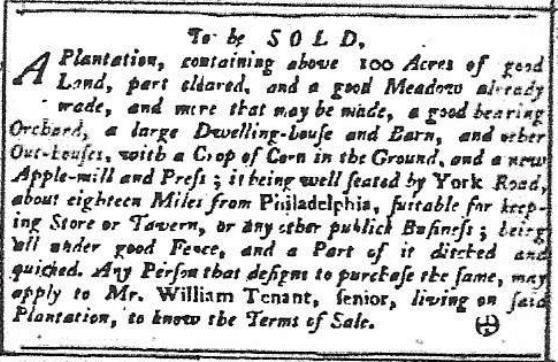
As intriguing as it is to think that maybe the house on the plantation was used as a Store before Tennent owned it, an additional source came along and opened up a real can of worms regarding John Linter…
The Tavern
The following paragraph, extracted from William W. H. Davis’ 1876 History of Bucks County, is the first clue we discovered that John Linter may have intended the house to be opened first as a Tavern:
“So far as we have any means of knowing, Warminster has never had more than one public house, and probably the site of the earliest was on or near where the present one stands. As early as 1730 one Thomas Linter petitioned the court for a recommendation for license “to keep a house of entertainment for man and horse.” In this he states that he is an inhabitant of Warminster, “county de Bucks,” and owns a house and good plantation on the York road, near the cross roads, and not far from “ye forks.” In 1732 Thomas Davids, of Northampton, attorney-in-fact for Thomas Linter, sold his farm of an hundred acres to David Howell, of Philadelphia, whereupon he removed to New York. In more modern times the Warminster hostelry, located near the junction of the York and Street roads, has been quite noted. Half a century ago, when horse-racing was much more common than now, it was frequented by those who indulged in this sport. It was then kept by Thomas Beans, a famous horseman…”
Some of the information described in the above reference seems to closely match the circumstances of the 1732 deed from John Linter to Joseph Howell and the actual letter of attorney between John Linter and Thomas Davids. In the case of this reference, John Linter is referred to as “Thomas Linter” and Joseph Howell is referred to as “David Howell”, but all other information and the name of the attorney match. The problem is the referenced tavern at York and Street Roads is not on the 100 acre plantation, but still standing on what was known as “Cadwallader’s Land” in the early 18th century. The well-known tavern is currently open for business as Mike’s York Street Bar and Grill. We did attempt to search for the original Linter petition or some other official record of it at the Bucks County Historical Society, but were unsuccessful in finding any information that would indicate Linter was granted the license. In fact, when going through the sources available regarding Bucks County tavern licenses, it appears a John Baldwin of Warminster was the earliest resident of the township to acquire a license in 1744. To complicate matters further, we noticed in Warren Ely’s 1905 revision of Davis’ history of the same above quoted reference that he had changed “Linter” to “Linton”, which effectively changed our John Linter to “Thomas Linton”.
If you have ever used Davis’ History of Bucks County or Ely’s 1905 revision for research purposes, you probably have noticed that Davis and Ely occasionally misspelled or misused names. It is not uncommon to come across Ely correcting Davis either.
In trying to understand why Linter’s and Howell’s first names were possibly changed by Davis, a couple of thoughts came to mind. John’s name was changed to “Thomas” and Joseph’s to “David”. Then we looked again at the name of the attorney “Thomas Davids” and wondered if Davis replaced those first names with the attorney’s first and last names! A coincidence, maybe?
We searched for any additional information about Linter in the Bucks County Historical Society’s archival database, but found nothing on that last name. On the other hand, there is an archival reference to the genealogical sketch of the Linton family who appear to have had a presence in Bucks County. This may explain why Ely changed Linter’s last name to Linton.
Regardless of why Davis and Ely may have changed those names, it was beginning to become clear that it was necessary to find out if John Linter did have any ownership history with the tavern at York and Street Roads.
We went back to the Linter to Davids letter of attorney to see if there was mention of any specific properties in Warminster, but found this document offered no additional clues.
We consulted with the Heritage Conservancy in Doylestown to see if they had any ownership records for the Mike’s York Street Bar and Grill tavern. They were able to provide us with a chain of title record for the “Warminster Manor” (aka Mike’s) and past articles written about it.
On this chain of title, the earliest deed located was a 154 acre parcel from William Dilworth and William Buckman; executors under the will of Joseph Dilworth, Warminster yeoman, (deceased, dated May 19, 1775) to Amos Dilworth, a Warminster yeoman, on April 1, 1782 for 1663.17 pounds. Amos Dilworth on the same day mortgaged the property to Jonathan Walton. Then on May 16, 1791, Amos, now described as a Philadelphia gentleman, sold the 154 acres to Isaac Beans, Warminster yeoman, for 1300 pounds. The 154 acres is listed as “being 2 tracts” those two tracts being divided in the 1791 transaction as “85 ¼ ac & 68 ac 130 p”. William and Amos were Joseph’s sons and William Buckman was the husband of Joseph’s daughter, Hannah.
We did secure a copy of the actual will of Joseph Dilworth. Included with the will was a 4 ½ page inventory valued at over 688 pounds which was filed in 1781, and a settlement of account with a balance of over 2,499 pounds filed June 12, 1792 with names listed such as John Hart, Jonathan Walton, John Jarret, Daniel Longstreth and Adam Carr. The will was proved on January 13, 1781, and there is every indication that Joseph Dilworth died a wealthy man.
Unfortunately, the chain of title did not offer any additional information about the earliest history of the tavern, but a 1908 Daily Intelligencer article titled “Warminster Hotel” included in the Conservancy’s record indicated a perpetuation of Davis’ and Ely’s references along with an additional interpretation of the history of the tavern. The article states:
“In 1701 Noble Cooper acquired 670 acres of land hereabouts, covering both sides of the York road, and extending to the county line. It included the later Stacy Beans farm to the westward. His son, Joseph Cooper, inherited much of this land, which in 1762 he sold to Joseph Dilworth, a cooper. Meantime Thomas Linton had acquired 100 acres, upon which he built a house on the present hotel site. It was in 1730 that Linton first acquired a license. In 1732 he sold this to David Howell, of Philadelphia. When Howell lost possession, we know not, but in 1775 Joseph Dilworth sold the plantation hearabout for 1300 pounds. His will was made that year and Amos Dilworth acquired the property and the Dilworth family were the owners during the Revolution.”
We initially thought we had a good starting point with the Cooper family as the earliest owners of the tavern property, but in reviewing the above reference again, it appeared there were two different properties being discussed here. In looking at the chain of title again, we rehashed that Joseph Dilworth had not sold the tavern property for 1300 pounds in 1775, but that his son Amos had acquired the property from his father’s estate in 1782 and then sold it to Isaac Beans in 1791 for 1300 pounds. I became highly suspicious that this article might be a real quagmire of errors, especially with the potential “whisper down the lane” factor developing with our John Linter (aka “Thomas Linton”).We also found Mike’s York Street Bar and Grill had a handout with a brief history of the tavern building, including a list of previous owners and a few images of the tavern as it appeared in previous years. It is highly suspected the source of the majority of this information came from the Conservancy’s record on the tavern. With the chain of title stopping at the April, 1782 Joseph Dilworth estate to Amos Dilworth deed. Mike’s tried to fill the gap of the earliest ownership of the tavern by using the information from the 1908 article, showing Noble Cooper and son Joseph Cooper (670 acres) sold the property to Joseph Dilworth in 1762; Thomas Linton (100 acres) sold to David Howell in 1732; and finally an unknown sold Thomas Linton the property where he then “Built Warminster Hotel in 1730”.
Unfortunately, subsequent histories and articles perpetuated the tavern’s history with Linter (or Linton) and the 1730 build date of the tavern.
We had to find a better way to discover who owned the tavern property at the same time that John Linter owned the Tennent 100 acres, which was a short period of time between 1728 and 1732. So we decided to locate the earliest available map of Warminster; a 1737 roads map at the Bucks County Historical Society discussing the laying out of Street Road. In fact in Ely’s Bucks County history, the planning of Street Road is described: “In April, 1737, a jury laid it out from the Buck road nearly its entire length, although portions of it had been laid out before, as between Johnsville and York road, 1731.”
Following is a part of that map where Street Road is the dotted line running east-west with the York Road crossing it. (York Road had not become “Old” yet.) As you can see, the southern property line of the 100-acre Tennent plantation adjoins Street Road as well as part of the property to its south, Cadwallader’s Land, which appeared to be about a 300+ acre plantation at that time. Now in observing this map, you’ll notice the diagonally running York Road cuts through the Tennent and Cadwallader properties at their northeast corners. The Tennent House is located just west of the road (red arrow) and the same is true of the tavern building, also located just west of the road (yellow arrow). The first question to come to mind was why wasn’t the name Cadwallader mentioned in any of the written histories of the tavern at York and Street Roads?
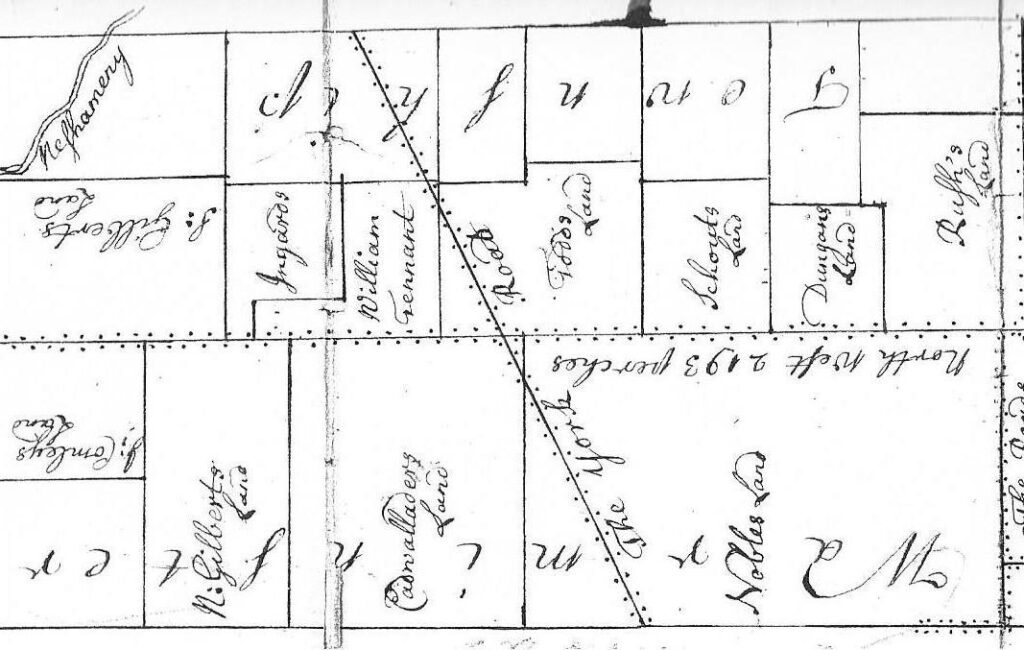
After staring at this map on multiple occasions, it dawned on us to retrieve the earliest deed documents of the Tennent property we had on record and read the metes and bounds descriptions to see if Cadwallader was mentioned. Sure enough, we found that the “Land of John Cadwallader” was described as an adjoining property to the 100-acre plantation in the May 9, 1730 John Linter to John Roberts mortgage; June 30, 1732 John Linter to Joseph Howell deed; August 30, 1735 Timothy Smith to John White deed; and the September 11, 1735 John White to William Tennent deed. These primary documents seemed to establish John Cadwallader’s ownership of the property south of Street Road at least between 1730 and 1735 with the roads map indicating his ownership possibly extended to 1737. We realized we needed to find out more about John Cadwallader and when he might have acquired this large tract.
John Cadwallader was born in 1676 in Wales. He was a Quaker minister “and was very eminent in the early religious history of the Province of Pennsylvania. He made many trips to other provinces in the United States and abroad to other countries”. He married Mary Cassel in 1701 in Abington, Pa. John helped to establish a log meeting house in Horsham in 1714. Mary died in 1728 “and was buried at Horsham where she and John had lived”. He then married Margaret Peters, a Warminster widow, in April, 1730. John then acquired land in Warminster where he and Margaret lived until John died on September 7, 1742 in Tortola, West Indies.
Considering John Cadwallader is listed as an adjoining property owner in the May, 1730 John Linter to John Roberts mortgage, it appears he may have acquired the Warminster property very shortly after his marriage to Margaret.
So we managed at the very least to establish that John Cadwallader owned the property where the tavern is located at the same time that John Linter owned the Tennent property, during the period between May, 1730 and June, 1732 before Linter sold to Joseph Howell.
We kept searching for any additional information about the early ownership of the tavern property and referred to a very revealing Reconstruction of Historic Tracts Map created by the Bucks County Historical Society’s Warren Ely, most likely in the early 20th century, which depicts the names of the early to late 18th century landowners. Following is a portion of that map showing a good part of Warminster.
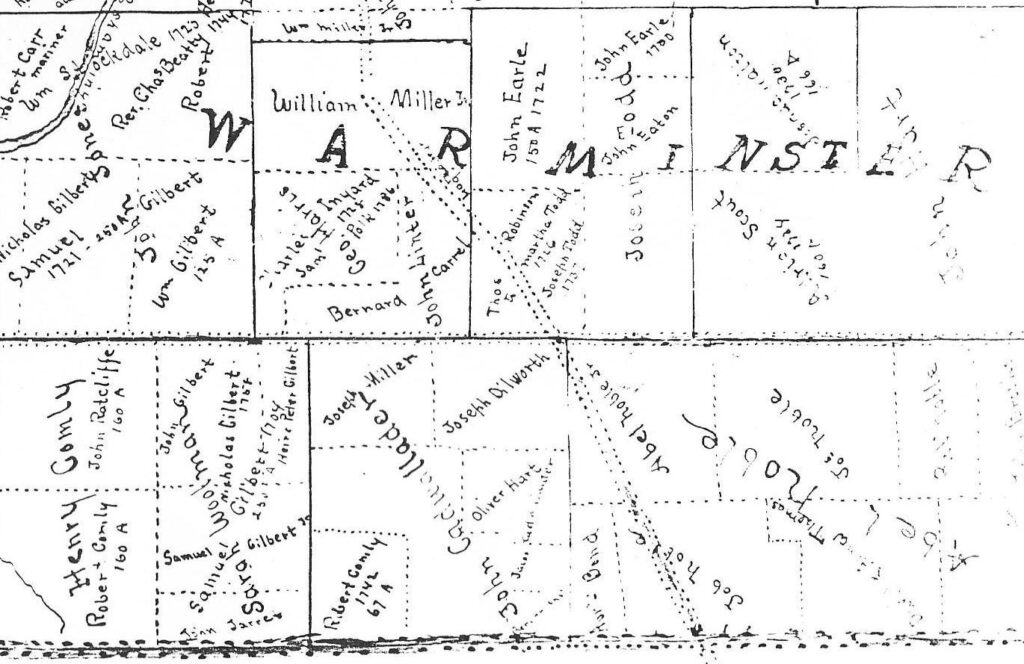
When you compare this map to the 1737 roads map, you can see the Tennent property has the names “John Linter” and “Bernard Carrel” included. As we know, Linter took ownership in 1728. Bernard Carrell’s ownership of the 100-acre plantation began in 1763. But a much more revealing aspect of this map is the depiction of the multiple subdivisions within the John Cadwallader tract. Joseph Dilworth was already becoming a person of interest because of the Conservancy’s chain of title and that 1908 article. Seeing his name written in on the smaller parcel where the tavern is located only increased that interest as we continued to investigate.
We were extremely fortunate to come across another source at the Bucks County Historical Society that appeared to coincide with the reconstruction map. In the Warminster Township Papers are “(Copies of Briefs of title of Warminster Properties) 1684-1823”. All of the briefs are written on what appears to be a school district census log with the printed year 1899. We found briefs for John Linter and John Cadwallader possibly written by the hand of Warren Ely. We compared the Linter brief to our deeds on record as well as other sources and the chain of title we have for the Tennent property, and noticed inconsistencies in some of the dates of transfer. So when we started to examine the brief of John Cadwallader, we knew other sources would eventually have to be compared with this information. The biggest challenge with this brief was that it was a bit difficult to decipher in some areas, so we did the best we could to extract understandable information.
The brief did not indicate who owned the approximate 330 acre parcel before John Cadwallader and his wife, Margaret. On December 1, 1736, John and Margaret transferred 164 ¼ acres to their son, Jacob. The next transfer took place on November 1, 1740 between John and Margaret and their son, Joseph, of 166 acres, 64 perches. Then on October 22, 1742, Joseph sold 116 of the 166 acres to his brother, Jacob. This deed was noted as being recorded in Philadelphia. We searched for the previous two transfers at the Bucks County Recorder of Deeds and could not locate them, assuming they are likely recorded in Philadelphia as well.
Also, according to the brief, it appears the first transaction where Jacob begins dividing the property further is with the sale of 67 ½ acres, 8 perches to Robert Comly on January 6, 1743. This deed discusses and effectively verifies both the previously mentioned November 1, 1740 and October 22, 1742 transactions indicating the 67 ½ acres are cut from the 116. This property is depicted on the reconstruction map in the southwest corner of the Cadwallader tract.
The most interesting piece of information on this brief was regarding Joseph Dilworth. Written at the bottom is: “John Cadwallader seems to have conveyed 150 a[cres] to Jos Dilworth”. There are a couple of reasons why this statement may have been written: Ely could not account for that acreage when calculating the other land transfers within the Cadwallader tract or he may have been referring to the 1782 Joseph Dilworth estate to Amos Dilworth deed discussing the 154 acres where the tavern is located. It is possible that Jacob sold the northeast corner property to Joseph Dilworth rather than his father, John, and this thought was reinforced by another land transfer listed on the brief and the actual deed itself; the 50-acre property sold by Jacob Cadwallader to Oliver Hart on July 30, 1748.
The summary of this deed is Jacob Cadwallader of Warminster Twp., yeoman and Magdalon his wife sold to Oliver Hart, a Warminster carpenter. The deed mentions John Cadwallader of Horsham, Philadelphia Mason and Margaret his wife, a certain tract or parcel of land in Warminster containing 164 ¾ acres conveyed to Jacob via certain indentures of lease and release, verifying the December 1, 1736 transaction from John to Jacob and that the 50 acres described in this deed were “part of the said” 164 3/4. It is described as a certain messuage/parcel of land and the metes and bounds description and adjoining properties, including Joseph Dilworth’s, match Oliver Hart’s property configuration on Ely’s reconstruction map, indicating Dilworth owned the York and Street Roads corner parcel as early as 1748.
In Ely’s 1905 revision of Davis’ Bucks County History, we found in the “Old Taverns” chapter a discussion about the Warminster tavern when Thomas Beans owned it in the early 19th century, and a reference to Dilworth stating, “When an inn was first licensed there we do not know, but as early as 1758, it was called “Dilworth’s tavern.” This is the only reference we have come across so far regarding the tavern where there is no mention of Linter or Linton or that the tavern was licensed or built in 1730.
Probably one of the most interesting items we came across at the Bucks County Historical Society regarding Joseph Dilworth was his Merchant Account Book for the years 1763-1765. 19th century articles obscure some pages at the beginning, but then you begin to see entries for items such as salt, pepper, tobacco, coffee, rice, sugar, molasses, sundrys; with the most frequent entry being “1 qt. rum”. This 358-page relic just has “Bucks County” as the identified location, but the consistent mention of names such as Miller, Hart, Heaton, Craven, Hough, Yerkes, Dungan, and Beatty indicate a strong possibility the business conducted, as represented in this book, took place in Warminster.
We looked for any deeds at the Bucks County Recorder of Deeds that would describe Joseph Dilworth acquiring any of the Cadwallader tract from either John or Jacob, but there were none to be found. The year 1748 rang a bell as this was the year James Carrell had acquired the Tennent 100 acres. I reviewed the May 7, 1748 deed from John Baldwin and Elizabeth, his wife to James Carrell and discovered in reading the property description and adjoining property names that a “John Johnsons (formerly John Cadwaladers)” was one of them. I immediately thought of a possible conflict with the mention of Joseph Dilworth as an adjoining property to the north of Oliver Hart’s in the July 30, 1748 Jacob Cadwallader to Oliver Hart deed. I expected to see Joseph Dilworth as one of the adjoining properties on the southern property line of Carrell’s, not just John Johnsons. This narrowed the possibility of Joseph Dilworth acquiring the northeast corner parcel of Cadwallader’s at some point between May 7th and July 30th in 1748. We did search for any deeds in Bucks County between Cadwallader to Johnsons and Johnsons to Dilworth to no avail. Of course, further research into how “Cadwallader’s Land” evolved is necessary.
Just one more point of interest regarding the year 1748…After the death of William Tennent, his wife, Catherine, and son, Gilbert, sold the Tennent property to John Baldwin on February 8, 1746/47. As previously mentioned, Baldwin sold the property to Carrell in 1748.
In the Bucks County Conservancy’s preliminary history of the Tennent property, it was thought, “This Baldwin may be the same John Baldwin who operated the tavern at the crossroads of York and Bristol Roads from 1744 to 1748.”
John Baldwin was the earliest on record, of Warminster, that we could locate who petitioned for a tavern license in 1744, which was confirmed in the Municipality Index of the Bucks County Tavern License Petitions for the years 1742-1868. In the Surname Index, John Baldwin and James Van Sandt are listed in the same file for the year 1748.
Also, in the “Old Taverns” chapter of Davis’ Bucks County History, “John Baldwin, at Hartsville, who moved away in 1748, and was succeeded by James Vansant…” is referred to while discussing the well known localities of area taverns. This statement is reinforced in the footnotes, “The tavern at Hartsville was always in Warwick”, which was the tavern at York and Bristol Roads.
Of course, just to add fuel to the fire of confusion on the history of the Warminster tavern, the following is stated in those same footnotes, “Baldwin kept at what was afterward “Beans’ ” tavern on the York road just below the Street road, the only public house in Warminster, then or since, so far as is known.” opening up the possibility he was involved with the northeast corner of the Cadwallader property prior to Dilworth, while possibly owning the Tennent property for a short period at the same time. Is it a coincidence that John Baldwin leaves the area in 1748, which is the same year our John Baldwin sells the 100 acres to Carrell? Obviously, more research is needed on this front.
Conclusion
We can only hope that the deeds we’ve been searching for related to the Cadwallader tract are somehow recorded in Philadelphia. Deeds are very good primary sources to rely on when secondary information such as written histories are in conflict. Even though the prperty history of the tavern is still filled with blank spots, we have contradicted quite a bit of what was perceived to be fact. It is very possible Joseph Dilworth opened the tavern at York and Street Roads for the first time as early as 1748. Clearly, the earliest ownership history of the tavern requires much further investigation.
The bottom line is the John Cadwallader property appears to remain intact as an approximate 330 acre tract from the time John takes ownership potentially in 1730 to 1736 when the first transfer of acreage takes place between John and his son, Jacob. There is no indication as of now that John Linter (or a Thomas Linton for that matter) had any ties to the Cadwallader property where the tavern, or “public house” Davis refers to in 1876, is located. The period of interest regarding John Linter was always a narrow one – between 1730 when he supposedly petitioned for a tavern license, and May of 1732 when he apparently has already moved to New York. One of the telltale pieces in Davis’ 1876 reference that really describes the Tennent property rather than Cadwallader’s is the phrase “sold his farm of an hundred acres” referring to the 1732 Linter to Howell transaction. Add that to the fact there are two Philadelphia shopkeepers with a wife in common involved with the Tennent property between 1730 and 1733 and that the house is consistently described as fit “for a Store or Tavern” between 1734 and 1744, makes it highly likely Linter had the Tennent property in mind when he “petitioned the court for a recommendation for license “to keep a house of entertainment for man and horse.”
Sources
A Preliminary History of “The William Tennent Property”, Bucks County Conservancy, 1986, Doylestown, PA, pages 2,6-7,14-15,17-19,33-39
“History of Neshaminy Presbyterian Church of Warwick, Hartsville, Bucks County, Pa., 1726-1876”, Rev. D. K. Turner, 1876, Philadelphia, pages 12-13 (footnotes)
Wills: Abstracts, Book E: 1726 – 1736: Philadelphia Co, PA, E.160, E.209 http://files.usgwarchives.net/pa/philadelphia/wills/willabstrbke.txt
Wills: Abstracts, Book G: 1743 – 1748/9: Philadelphia Co, PA, G.53 http://files.usgwarchives.net/pa/philadelphia/wills/willabstrbkg.txt
Merchants and mercantile life in colonial Philadelphia, 1748-1763, Harry D. Berg, University of Iowa, 1940 https://ir.uiowa.edu/cgi/viewcontent.cgi?article=6265&context=etd
Nurse Family History – Colonel Abraham Taylor
http://www.nursefamily.ca/post/Colonel-Abraham-Taylor-Born-1702
The following records from the Bucks County Recorder of Deeds Office, Doylestown, PA:
- Bucks County Deed Book 5 Page 339, 100 acres, messuage & tract, Mortgage John Linter to John Roberts, May 29, 1730
- Bucks County Deed Book 6 Page 55, 100 acres, messuage & tract, John Linter to Joseph Howell, June 30, 1732
- Bucks County Deed Book 27 Page 33, 67 ½ acres, 8 perches, piece of land, Jacob Cadwallader to Robert Comly, January 6, 1742/43
- Bucks County Deed Book 7 Page 470, 50 acres, messuage & parcel, Jacob Cadwallader to Oliver Hart, July 30, 1748
- Bucks County Deed Book 19 Page 369, 154 acres 10 perches, messuage plantation, Mortgage Amos Dilworth to Jonathan Walton, April 1, 1782
- Letter of Attorney, John Linter to Thomas Davids, May 2, 1732, Recorded in the Roles office for the County of Bucks in Book B, Vol. 2, Pages 22, 23
The History of Bucks County, Pennsylvania, From the Discovery of the Delaware to the Present Time, William Watts Hart Davis, A. M., 1876, page 225
History of Bucks County, Pennsylvania, From the Discovery of the Delaware to the Present Time, By William W.H. Davis, A.M., Vol. I, 2nd Edition Revised, Warren S. Ely and John W. Jordan, 1905, Page 196
Warminster Manor, Tax Parcel #49-9-3, Chain of Title and Newspaper Histories, Bucks County Conservancy, Doylestown, PA
Will of Joseph Dilworth, Book D, pages 95, 96, year 1781, #1677, Bucks County Register of Wills, Doylestown, PA
History of the Building/Ownership and Related Images Handout, Mike’s York Street Bar and Grill, York and Street Roads, Warminster, PA
History of Bucks County, Pennsylvania, From the Discovery of the Delaware to the Present Time, By William W.H. Davis, A.M., Vol. II, 2nd Edition Revised, Warren S. Ely and John W. Jordan, 1905, Pages 249-250, 335, 342
The following sources from the Spruance Library, Bucks County Historical Society, Doylestown, PA: - Plan Map for the Street Road, April 23, 1737, Bucks County Roads (Fol. 1)
- Reconstruction of Historic Tracts Map, Warren S. Ely (Drawer 4, Fol. 4)
- (Copies of Briefs of title of Warminster Properties) 1684-1823, Warminster Township Papers (Fol. 3)
- Joseph Dilworth Merchant Account Book, 1763-1765, 358 pages (MSC 438)
- Linton Family, The Origin of (Genealogy). 1692 – 1709, Miscellaneous Collections (MSC 163)
John Cadwalader http://www.clan-home.org/tree/16527.htm
Descendants of John Cadwallader http://www.cadwalladertree.org/chapter_1.htm
Bucks County Tavern License Petitions, 1742-1868, Vol. 1, Bucks County Historical Society, Doylestown, PA, 1996, Municipality Index, page 138; Surname Index, page 3
The Tavern in Colonial America http://cupola.gettysburg.edu/cgi/viewcontent.cgi?article=1026&context=ghj
